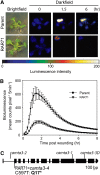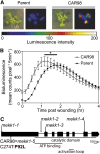Distinct roles for mitogen-activated protein kinase signaling and CALMODULIN-BINDING TRANSCRIPTIONAL ACTIVATOR3 in regulating the peak time and amplitude of the plant general stress response
- PMID: 25157030
- PMCID: PMC4213123
- DOI: 10.1104/pp.114.245944
Distinct roles for mitogen-activated protein kinase signaling and CALMODULIN-BINDING TRANSCRIPTIONAL ACTIVATOR3 in regulating the peak time and amplitude of the plant general stress response
Abstract
To survive environmental challenges, plants have evolved tightly regulated response networks, including a rapid and transient general stress response (GSR), followed by well-studied stress-specific responses. The mechanisms underpinning the GSR have remained elusive, but a functional cis-element, the rapid stress response element (RSRE), is known to confer transcription of GSR genes rapidly (5 min) and transiently (peaking 90-120 min after stress) in vivo. To investigate signal transduction events in the GSR, we used a 4xRSRE:LUCIFERASE reporter in Arabidopsis (Arabidopsis thaliana), employing complementary approaches of forward and chemical genetic screens, and identified components regulating peak time versus amplitude of RSRE activity. Specifically, we identified a mutant in CALMODULIN-BINDING TRANSCRIPTIONAL ACTIVATOR3 (CAMTA3) with reduced RSRE activation, verifying this transcription factor's role in activation of the RSRE-mediated GSR. Furthermore, we isolated a mutant in MITOGEN-ACTIVATED PROTEIN KINASE (MAPK) KINASE KINASE1 (mekk1-5), which displays increased basal and an approximately 60-min earlier peak of wound-induced RSRE activation. The double mekk1/camta3 mutant positioned CAMTA3 downstream of MEKK1 and verified their distinct roles in GSR regulation. mekk1-5 displays programmed cell death and overaccumulates reactive oxygen species and salicylic acid, hallmarks of the hypersensitive response, suggesting that the hypersensitive response may play a role in the RSRE phenotype in this mutant. In addition, chemical inhibition studies suggest that the MAPK network is required for the rapid peak of the RSRE response, distinguishing the impact of chronic (mekk1-5) from transient (chemical inhibition) loss of MAPK signaling. Collectively, these results reveal underlying regulatory components of the plant GSR and further define their distinct roles in the regulation of this key biological process.
© 2014 American Society of Plant Biologists. All Rights Reserved.
Figures







References
-
- Alonso JM, Stepanova AN, Leisse TJ, Kim CJ, Chen H, Shinn P, Stevenson DK, Zimmerman J, Barajas P, Cheuk R, et al. (2003) Genome-wide insertional mutagenesis of Arabidopsis thaliana. Science 301: 653–657 - PubMed
-
- Andreasson E, Ellis B. (2010) Convergence and specificity in the Arabidopsis MAPK nexus. Trends Plant Sci 15: 106–113 - PubMed
-
- Asai T, Tena G, Plotnikova J, Willmann MR, Chiu WL, Gomez-Gomez L, Boller T, Ausubel FM, Sheen J. (2002) MAP kinase signalling cascade in Arabidopsis innate immunity. Nature 415: 977–983 - PubMed
-
- Benn G, Wang CQ, Hicks DR, Stein J, Guthrie C, Dehesh K. (August 18, 2014) A key general stress response motif is regulated non-uniformly by CAMTA transcription factors. Plant J http://dx.doi.org/10.1111/tpj.12620 - DOI - PMC - PubMed
-
- Bethke G, Pecher P, Eschen-Lippold L, Tsuda K, Katagiri F, Glazebrook J, Scheel D, Lee J. (2012) Activation of the Arabidopsis thaliana mitogen-activated protein kinase MPK11 by the flagellin-derived elicitor peptide, flg22. Mol Plant Microbe Interact 25: 471–480 - PubMed
Publication types
MeSH terms
Substances
Grants and funding
LinkOut - more resources
Full Text Sources
Other Literature Sources
Molecular Biology Databases
Miscellaneous

